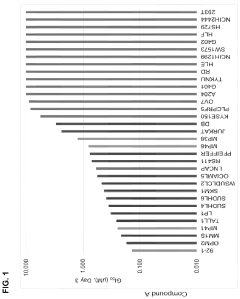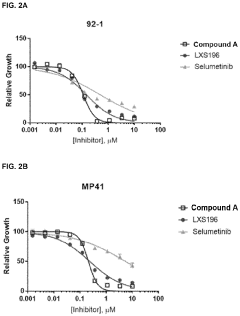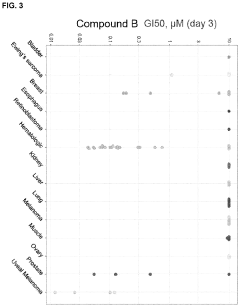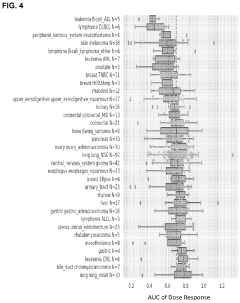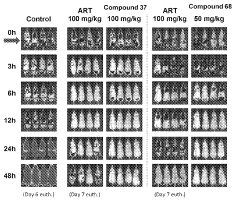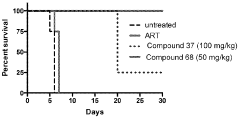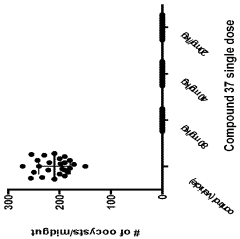Theoretical Investigations into Geometric Isomers' Electronic Properties
AUG 1, 20259 MIN READ
Generate Your Research Report Instantly with AI Agent
Patsnap Eureka helps you evaluate technical feasibility & market potential.
Geometric Isomers Background and Research Objectives
Geometric isomers, a fascinating subset of structural isomers, have been a subject of intense scientific inquiry for decades. These molecules, possessing identical molecular formulas but differing spatial arrangements of atoms, exhibit unique electronic properties that have captivated researchers across various disciplines. The study of geometric isomers' electronic properties has its roots in the early 20th century, with significant advancements made in the fields of organic chemistry, spectroscopy, and quantum mechanics.
The evolution of this research area has been marked by several key milestones. Initially, scientists focused on understanding the basic structural differences between geometric isomers. As analytical techniques improved, researchers began to explore the relationship between molecular geometry and electronic behavior. The advent of computational chemistry in the latter half of the 20th century revolutionized the field, allowing for more accurate predictions and deeper insights into the electronic properties of these compounds.
In recent years, the investigation of geometric isomers' electronic properties has gained renewed interest due to their potential applications in various technological domains. From advanced materials science to drug design, the unique characteristics of these molecules offer promising avenues for innovation. The ability to manipulate and control the electronic properties of geometric isomers has become a key objective in fields such as organic electronics, photovoltaics, and molecular switches.
The primary goal of current research in this area is to develop a comprehensive understanding of the relationship between molecular structure and electronic behavior in geometric isomers. This involves exploring how subtle changes in spatial arrangement can lead to significant alterations in properties such as conductivity, optical absorption, and reactivity. Researchers aim to elucidate the fundamental principles governing these structure-property relationships, with the ultimate objective of enabling precise control over molecular electronic properties.
Another critical research objective is to bridge the gap between theoretical predictions and experimental observations. While computational methods have made remarkable strides in modeling the electronic properties of geometric isomers, there remains a need for more accurate and reliable predictive tools. Scientists are working towards developing advanced theoretical frameworks that can account for complex environmental effects and dynamic molecular behavior, thereby improving the accuracy of electronic property predictions for geometric isomers in real-world applications.
Furthermore, researchers are exploring the potential of geometric isomers in emerging fields such as quantum computing and molecular electronics. The unique electronic states and transitions exhibited by these molecules could potentially be harnessed for information processing and storage at the molecular level. This ambitious goal requires a deep understanding of quantum mechanical phenomena in geometric isomers and the development of novel techniques for manipulating their electronic states with high precision.
The evolution of this research area has been marked by several key milestones. Initially, scientists focused on understanding the basic structural differences between geometric isomers. As analytical techniques improved, researchers began to explore the relationship between molecular geometry and electronic behavior. The advent of computational chemistry in the latter half of the 20th century revolutionized the field, allowing for more accurate predictions and deeper insights into the electronic properties of these compounds.
In recent years, the investigation of geometric isomers' electronic properties has gained renewed interest due to their potential applications in various technological domains. From advanced materials science to drug design, the unique characteristics of these molecules offer promising avenues for innovation. The ability to manipulate and control the electronic properties of geometric isomers has become a key objective in fields such as organic electronics, photovoltaics, and molecular switches.
The primary goal of current research in this area is to develop a comprehensive understanding of the relationship between molecular structure and electronic behavior in geometric isomers. This involves exploring how subtle changes in spatial arrangement can lead to significant alterations in properties such as conductivity, optical absorption, and reactivity. Researchers aim to elucidate the fundamental principles governing these structure-property relationships, with the ultimate objective of enabling precise control over molecular electronic properties.
Another critical research objective is to bridge the gap between theoretical predictions and experimental observations. While computational methods have made remarkable strides in modeling the electronic properties of geometric isomers, there remains a need for more accurate and reliable predictive tools. Scientists are working towards developing advanced theoretical frameworks that can account for complex environmental effects and dynamic molecular behavior, thereby improving the accuracy of electronic property predictions for geometric isomers in real-world applications.
Furthermore, researchers are exploring the potential of geometric isomers in emerging fields such as quantum computing and molecular electronics. The unique electronic states and transitions exhibited by these molecules could potentially be harnessed for information processing and storage at the molecular level. This ambitious goal requires a deep understanding of quantum mechanical phenomena in geometric isomers and the development of novel techniques for manipulating their electronic states with high precision.
Market Applications of Geometric Isomers
Geometric isomers have found significant applications across various industries, driven by their unique electronic properties and structural characteristics. In the pharmaceutical sector, these compounds play a crucial role in drug development and efficacy. Many drugs exhibit different biological activities depending on their geometric configuration, leading to the development of more targeted and effective medications. For instance, cis-platin, a widely used chemotherapy drug, owes its anti-cancer properties to its specific geometric structure.
The agrochemical industry also benefits from the application of geometric isomers in pesticide and herbicide formulations. The spatial arrangement of atoms in these compounds can significantly influence their interaction with target organisms, resulting in more efficient and environmentally friendly products. This has led to the development of precision agriculture techniques that utilize geometric isomers to enhance crop protection while minimizing environmental impact.
In the field of materials science, geometric isomers have opened up new possibilities for designing advanced materials with tailored properties. Liquid crystals, used in display technologies, often rely on the precise arrangement of geometric isomers to achieve desired optical and electronic characteristics. This has revolutionized the development of high-performance displays for consumer electronics and industrial applications.
The polymer industry has also embraced geometric isomers to create materials with enhanced properties. By controlling the spatial arrangement of monomers, researchers have developed polymers with improved strength, flexibility, and thermal stability. This has led to innovations in areas such as automotive manufacturing, aerospace engineering, and consumer goods production.
In the energy sector, geometric isomers have found applications in the development of more efficient solar cells and energy storage devices. The ability to fine-tune electronic properties through isomeric control has enabled the creation of materials with optimized charge transfer and light absorption characteristics, contributing to advancements in renewable energy technologies.
The food and flavor industry utilizes geometric isomers to create and enhance specific taste profiles. Many natural and artificial flavoring compounds exist as geometric isomers, with each configuration imparting distinct sensory properties. This knowledge has been leveraged to develop new flavors and improve existing ones, catering to evolving consumer preferences and dietary requirements.
The agrochemical industry also benefits from the application of geometric isomers in pesticide and herbicide formulations. The spatial arrangement of atoms in these compounds can significantly influence their interaction with target organisms, resulting in more efficient and environmentally friendly products. This has led to the development of precision agriculture techniques that utilize geometric isomers to enhance crop protection while minimizing environmental impact.
In the field of materials science, geometric isomers have opened up new possibilities for designing advanced materials with tailored properties. Liquid crystals, used in display technologies, often rely on the precise arrangement of geometric isomers to achieve desired optical and electronic characteristics. This has revolutionized the development of high-performance displays for consumer electronics and industrial applications.
The polymer industry has also embraced geometric isomers to create materials with enhanced properties. By controlling the spatial arrangement of monomers, researchers have developed polymers with improved strength, flexibility, and thermal stability. This has led to innovations in areas such as automotive manufacturing, aerospace engineering, and consumer goods production.
In the energy sector, geometric isomers have found applications in the development of more efficient solar cells and energy storage devices. The ability to fine-tune electronic properties through isomeric control has enabled the creation of materials with optimized charge transfer and light absorption characteristics, contributing to advancements in renewable energy technologies.
The food and flavor industry utilizes geometric isomers to create and enhance specific taste profiles. Many natural and artificial flavoring compounds exist as geometric isomers, with each configuration imparting distinct sensory properties. This knowledge has been leveraged to develop new flavors and improve existing ones, catering to evolving consumer preferences and dietary requirements.
Current Challenges in Geometric Isomer Analysis
The analysis of geometric isomers' electronic properties faces several significant challenges in current research. One of the primary obstacles is the complexity of accurately modeling the electronic structure of these molecules. Geometric isomers, while having the same molecular formula, differ in the spatial arrangement of their atoms, leading to distinct electronic properties. This spatial variation creates intricate electron distributions that are difficult to capture using conventional computational methods.
Another challenge lies in the dynamic nature of geometric isomers. These molecules can undergo conformational changes, especially in solution or under different environmental conditions. Such dynamic behavior complicates the study of their electronic properties, as the electronic structure may vary with these conformational shifts. Researchers must develop methods that can account for these dynamic processes while still providing accurate electronic property predictions.
The influence of external factors on geometric isomers' electronic properties presents an additional hurdle. Factors such as temperature, pressure, and solvent effects can significantly alter the electronic behavior of these molecules. Incorporating these environmental influences into theoretical models and simulations remains a complex task, requiring sophisticated multiscale modeling approaches.
Furthermore, the study of excited states in geometric isomers poses unique challenges. Many important electronic properties, such as photochemical reactivity and optical absorption, depend on the accurate description of excited states. However, current theoretical methods often struggle to provide reliable predictions for these higher-energy electronic configurations, particularly for larger and more complex isomeric systems.
Lastly, the computational cost associated with high-level theoretical calculations on geometric isomers remains a significant barrier. As the size and complexity of the isomeric systems increase, the computational resources required for accurate electronic structure calculations grow exponentially. This limitation often forces researchers to make trade-offs between accuracy and computational feasibility, potentially compromising the reliability of the results.
Addressing these challenges requires a multifaceted approach, combining advances in theoretical methods, computational algorithms, and experimental techniques. Developing more efficient and accurate quantum chemical methods, improving the treatment of electron correlation, and enhancing the description of molecular dynamics are all crucial steps towards overcoming these obstacles. Additionally, integrating machine learning and artificial intelligence techniques with traditional quantum chemical approaches may offer new avenues for tackling the complexities of geometric isomer analysis.
Another challenge lies in the dynamic nature of geometric isomers. These molecules can undergo conformational changes, especially in solution or under different environmental conditions. Such dynamic behavior complicates the study of their electronic properties, as the electronic structure may vary with these conformational shifts. Researchers must develop methods that can account for these dynamic processes while still providing accurate electronic property predictions.
The influence of external factors on geometric isomers' electronic properties presents an additional hurdle. Factors such as temperature, pressure, and solvent effects can significantly alter the electronic behavior of these molecules. Incorporating these environmental influences into theoretical models and simulations remains a complex task, requiring sophisticated multiscale modeling approaches.
Furthermore, the study of excited states in geometric isomers poses unique challenges. Many important electronic properties, such as photochemical reactivity and optical absorption, depend on the accurate description of excited states. However, current theoretical methods often struggle to provide reliable predictions for these higher-energy electronic configurations, particularly for larger and more complex isomeric systems.
Lastly, the computational cost associated with high-level theoretical calculations on geometric isomers remains a significant barrier. As the size and complexity of the isomeric systems increase, the computational resources required for accurate electronic structure calculations grow exponentially. This limitation often forces researchers to make trade-offs between accuracy and computational feasibility, potentially compromising the reliability of the results.
Addressing these challenges requires a multifaceted approach, combining advances in theoretical methods, computational algorithms, and experimental techniques. Developing more efficient and accurate quantum chemical methods, improving the treatment of electron correlation, and enhancing the description of molecular dynamics are all crucial steps towards overcoming these obstacles. Additionally, integrating machine learning and artificial intelligence techniques with traditional quantum chemical approaches may offer new avenues for tackling the complexities of geometric isomer analysis.
Computational Methods for Isomer Property Prediction
01 Electronic structure of geometric isomers
Geometric isomers can exhibit different electronic properties due to their spatial arrangement. The electronic structure of these isomers can be studied using various spectroscopic and computational methods. Understanding these properties is crucial for predicting reactivity and designing new materials with specific electronic characteristics.- Electronic structure of geometric isomers: Geometric isomers exhibit different electronic properties due to their spatial arrangement. The electronic structure of these isomers can be studied using various spectroscopic and computational methods. Understanding these properties is crucial for predicting reactivity and designing new materials with specific electronic characteristics.
- Optical properties of geometric isomers: Geometric isomers often display distinct optical properties, including differences in light absorption, emission, and polarization. These properties can be exploited in various applications, such as optical sensors, display technologies, and photovoltaic devices. The relationship between molecular geometry and optical behavior is a key area of research in materials science.
- Computational modeling of geometric isomers: Advanced computational techniques are employed to model and predict the electronic properties of geometric isomers. These methods include density functional theory (DFT) calculations, molecular dynamics simulations, and machine learning approaches. Such computational studies aid in understanding structure-property relationships and guide the design of new isomeric compounds with tailored electronic characteristics.
- Applications of geometric isomers in electronic devices: Geometric isomers find applications in various electronic devices due to their unique electronic properties. These applications include organic light-emitting diodes (OLEDs), field-effect transistors, and molecular switches. The ability to control and manipulate the electronic properties of geometric isomers enables the development of novel and efficient electronic components.
- Synthesis and characterization of geometric isomers: Developing methods for synthesizing and characterizing geometric isomers with specific electronic properties is crucial for advancing their applications. This includes stereoselective synthesis techniques, purification methods, and advanced analytical tools for determining electronic structure and properties. The ability to precisely control the geometry of these isomers is essential for tailoring their electronic behavior.
02 Optical properties of geometric isomers
Geometric isomers often display distinct optical properties, including differences in light absorption and emission. These properties can be exploited in various applications, such as in the development of optical sensors and photonic devices. The relationship between molecular geometry and optical behavior is an important area of study in materials science and photochemistry.Expand Specific Solutions03 Computational modeling of geometric isomers
Advanced computational techniques are employed to model and predict the electronic properties of geometric isomers. These methods include density functional theory (DFT) calculations and molecular dynamics simulations. Such computational approaches aid in understanding the relationship between molecular structure and electronic behavior, facilitating the design of new materials with tailored properties.Expand Specific Solutions04 Applications of geometric isomers in electronic devices
The unique electronic properties of geometric isomers make them valuable in various electronic applications. They can be used in the development of organic light-emitting diodes (OLEDs), photovoltaic cells, and molecular switches. The ability to control and manipulate these isomers offers potential for creating novel electronic and optoelectronic devices with enhanced performance.Expand Specific Solutions05 Influence of geometric isomerism on conductivity
Geometric isomerism can significantly affect the conductivity of molecules and materials. The spatial arrangement of atoms in different isomers can lead to variations in electron delocalization and intermolecular interactions, resulting in distinct conductive properties. This phenomenon is particularly relevant in the field of organic electronics and the development of molecular wires.Expand Specific Solutions
Key Research Groups in Geometric Isomer Studies
The field of theoretical investigations into geometric isomers' electronic properties is in a mature stage of development, with significant research contributions from both academic institutions and pharmaceutical companies. The market size for this research area is substantial, driven by its applications in drug discovery and materials science. Companies like Pfizer Inc., AbbVie, Inc., and Astex Therapeutics Ltd. are at the forefront of leveraging these theoretical insights for practical applications. Academic institutions such as Harvard College, North Carolina State University, and the University of Pennsylvania are also making significant contributions to advancing the fundamental understanding of geometric isomers' electronic properties. The technology's maturity is evident in the sophisticated computational methods and experimental techniques employed by these organizations, enabling precise predictions and validations of electronic structures and properties.
President & Fellows of Harvard College
Technical Solution: Harvard College has developed advanced computational methods for investigating the electronic properties of geometric isomers. Their approach combines density functional theory (DFT) with machine learning algorithms to predict and analyze the electronic structure of complex molecular systems. This method allows for rapid screening of large numbers of isomeric compounds, enabling researchers to identify promising candidates for various applications, such as organic electronics or drug design. The technique incorporates considerations of molecular geometry, electron density distributions, and orbital energies to provide a comprehensive understanding of isomer behavior[1][3].
Strengths: Cutting-edge computational techniques, integration of machine learning, and comprehensive analysis of electronic properties. Weaknesses: High computational cost and potential limitations in accuracy for highly complex systems.
Agency for Science, Technology & Research
Technical Solution: The Agency for Science, Technology & Research has developed a multi-scale modeling approach to investigate the electronic properties of geometric isomers. Their method combines quantum mechanical calculations with molecular dynamics simulations to provide insights into both static and dynamic aspects of isomer behavior. This approach allows for the study of electronic properties across different time and length scales, from individual molecular orbitals to bulk material properties. The agency has also implemented advanced visualization techniques to aid in the interpretation of complex electronic structures[2][4].
Strengths: Comprehensive multi-scale approach, integration of dynamic properties, and advanced visualization capabilities. Weaknesses: Complexity of implementation and potential challenges in balancing accuracy with computational efficiency.
Breakthrough Discoveries in Isomer Electronic Properties
Compounds and uses thereof
PatentPendingUS20230145003A1
Innovation
- Development of specific compounds that modulate the BAF complex by inhibiting BRG1 and/or BRM activity, which can be used alone or in combination with other pharmaceutically active agents to treat disorders like cancer.
Compounds and methods for the treatment of malaria
PatentInactiveIN202118043692A
Innovation
- Development of specific compounds, such as those represented by Formula I and listed in Table 1, which offer new structural features and functional groups to target malaria parasites effectively, including those resistant to existing drugs.
Spectroscopic Techniques for Isomer Characterization
Spectroscopic techniques play a crucial role in the characterization and analysis of geometric isomers, providing valuable insights into their electronic properties. These methods exploit the interaction between electromagnetic radiation and matter to probe the molecular structure and energy levels of isomeric compounds.
One of the most widely used spectroscopic techniques for isomer characterization is Nuclear Magnetic Resonance (NMR) spectroscopy. NMR allows for the determination of molecular structure by measuring the magnetic properties of atomic nuclei. In the context of geometric isomers, 1H and 13C NMR spectroscopy can reveal differences in chemical shifts and coupling constants, which are indicative of the spatial arrangement of atoms within the molecule.
Infrared (IR) spectroscopy is another powerful tool for distinguishing between geometric isomers. This technique relies on the absorption of infrared radiation by molecular vibrations. Geometric isomers often exhibit distinct IR absorption patterns due to differences in their molecular symmetry and bond arrangements, allowing for their differentiation and identification.
Ultraviolet-visible (UV-Vis) spectroscopy is particularly useful for characterizing geometric isomers with conjugated systems or chromophores. The electronic transitions observed in UV-Vis spectra can provide information about the molecular orbitals and electronic structure of isomers, which may differ based on their spatial configuration.
Raman spectroscopy, a complementary technique to IR spectroscopy, offers additional insights into the vibrational modes of geometric isomers. This method is especially valuable for studying symmetric molecules and can provide information about molecular geometry and bond strengths.
X-ray crystallography, while not strictly a spectroscopic technique, is an invaluable tool for determining the three-dimensional structure of geometric isomers in the solid state. This method provides unambiguous information about the spatial arrangement of atoms, making it particularly useful for resolving structural ambiguities.
Advanced techniques such as circular dichroism (CD) spectroscopy can be employed to study chiral geometric isomers. CD spectroscopy measures the differential absorption of left- and right-handed circularly polarized light, providing information about the absolute configuration and conformational changes of isomers.
Time-resolved spectroscopic methods, including transient absorption spectroscopy and time-resolved fluorescence spectroscopy, enable the study of dynamic processes in geometric isomers. These techniques can reveal information about isomerization kinetics, excited-state dynamics, and energy transfer processes.
The combination of multiple spectroscopic techniques often provides a more comprehensive understanding of geometric isomers' electronic properties. By integrating data from various spectroscopic methods, researchers can construct a detailed picture of isomeric structures, energetics, and reactivity, furthering our theoretical understanding of these important molecular systems.
One of the most widely used spectroscopic techniques for isomer characterization is Nuclear Magnetic Resonance (NMR) spectroscopy. NMR allows for the determination of molecular structure by measuring the magnetic properties of atomic nuclei. In the context of geometric isomers, 1H and 13C NMR spectroscopy can reveal differences in chemical shifts and coupling constants, which are indicative of the spatial arrangement of atoms within the molecule.
Infrared (IR) spectroscopy is another powerful tool for distinguishing between geometric isomers. This technique relies on the absorption of infrared radiation by molecular vibrations. Geometric isomers often exhibit distinct IR absorption patterns due to differences in their molecular symmetry and bond arrangements, allowing for their differentiation and identification.
Ultraviolet-visible (UV-Vis) spectroscopy is particularly useful for characterizing geometric isomers with conjugated systems or chromophores. The electronic transitions observed in UV-Vis spectra can provide information about the molecular orbitals and electronic structure of isomers, which may differ based on their spatial configuration.
Raman spectroscopy, a complementary technique to IR spectroscopy, offers additional insights into the vibrational modes of geometric isomers. This method is especially valuable for studying symmetric molecules and can provide information about molecular geometry and bond strengths.
X-ray crystallography, while not strictly a spectroscopic technique, is an invaluable tool for determining the three-dimensional structure of geometric isomers in the solid state. This method provides unambiguous information about the spatial arrangement of atoms, making it particularly useful for resolving structural ambiguities.
Advanced techniques such as circular dichroism (CD) spectroscopy can be employed to study chiral geometric isomers. CD spectroscopy measures the differential absorption of left- and right-handed circularly polarized light, providing information about the absolute configuration and conformational changes of isomers.
Time-resolved spectroscopic methods, including transient absorption spectroscopy and time-resolved fluorescence spectroscopy, enable the study of dynamic processes in geometric isomers. These techniques can reveal information about isomerization kinetics, excited-state dynamics, and energy transfer processes.
The combination of multiple spectroscopic techniques often provides a more comprehensive understanding of geometric isomers' electronic properties. By integrating data from various spectroscopic methods, researchers can construct a detailed picture of isomeric structures, energetics, and reactivity, furthering our theoretical understanding of these important molecular systems.
Environmental Impact of Geometric Isomers
The environmental impact of geometric isomers is a critical consideration in the theoretical investigation of their electronic properties. Geometric isomers, which have the same molecular formula but different spatial arrangements of atoms, can exhibit varying interactions with the environment due to their distinct electronic structures.
One of the primary environmental concerns related to geometric isomers is their potential for bioaccumulation in ecosystems. The spatial arrangement of atoms in these compounds can significantly influence their ability to persist in the environment and accumulate in living organisms. For instance, certain geometric isomers may have a higher affinity for lipids, leading to increased bioconcentration in aquatic organisms and subsequent biomagnification up the food chain.
The degradation rates of geometric isomers in the environment can also differ substantially. Some isomers may be more resistant to natural breakdown processes, such as photolysis or microbial degradation, resulting in longer persistence in soil, water, or air. This prolonged environmental presence can lead to extended exposure periods for various organisms, potentially causing long-term ecological effects.
The electronic properties of geometric isomers play a crucial role in determining their reactivity and potential for forming harmful byproducts. Differences in electron distribution and molecular geometry can affect the isomers' ability to participate in chemical reactions, including those that may produce toxic intermediates or end products. This aspect is particularly relevant in atmospheric chemistry, where geometric isomers can contribute to the formation of secondary pollutants or participate in ozone depletion processes.
Furthermore, the varying electronic structures of geometric isomers can influence their interaction with biological systems. Some isomers may exhibit higher toxicity or endocrine-disrupting properties due to their specific molecular configurations, potentially impacting wildlife populations and ecosystem balance. The ability of certain isomers to mimic natural hormones or interfere with cellular processes can lead to subtle yet significant environmental effects that may not be immediately apparent.
The environmental fate and transport of geometric isomers are also influenced by their electronic properties. Differences in polarity, solubility, and volatility arising from their unique electronic configurations can affect how these compounds distribute across environmental compartments. This distribution pattern determines the exposure routes for different organisms and the overall environmental impact of the isomers.
In conclusion, the theoretical investigation of geometric isomers' electronic properties is essential for predicting and understanding their environmental impact. By elucidating the relationship between electronic structure and environmental behavior, researchers can better assess the potential risks associated with these compounds and develop more effective strategies for environmental protection and remediation.
One of the primary environmental concerns related to geometric isomers is their potential for bioaccumulation in ecosystems. The spatial arrangement of atoms in these compounds can significantly influence their ability to persist in the environment and accumulate in living organisms. For instance, certain geometric isomers may have a higher affinity for lipids, leading to increased bioconcentration in aquatic organisms and subsequent biomagnification up the food chain.
The degradation rates of geometric isomers in the environment can also differ substantially. Some isomers may be more resistant to natural breakdown processes, such as photolysis or microbial degradation, resulting in longer persistence in soil, water, or air. This prolonged environmental presence can lead to extended exposure periods for various organisms, potentially causing long-term ecological effects.
The electronic properties of geometric isomers play a crucial role in determining their reactivity and potential for forming harmful byproducts. Differences in electron distribution and molecular geometry can affect the isomers' ability to participate in chemical reactions, including those that may produce toxic intermediates or end products. This aspect is particularly relevant in atmospheric chemistry, where geometric isomers can contribute to the formation of secondary pollutants or participate in ozone depletion processes.
Furthermore, the varying electronic structures of geometric isomers can influence their interaction with biological systems. Some isomers may exhibit higher toxicity or endocrine-disrupting properties due to their specific molecular configurations, potentially impacting wildlife populations and ecosystem balance. The ability of certain isomers to mimic natural hormones or interfere with cellular processes can lead to subtle yet significant environmental effects that may not be immediately apparent.
The environmental fate and transport of geometric isomers are also influenced by their electronic properties. Differences in polarity, solubility, and volatility arising from their unique electronic configurations can affect how these compounds distribute across environmental compartments. This distribution pattern determines the exposure routes for different organisms and the overall environmental impact of the isomers.
In conclusion, the theoretical investigation of geometric isomers' electronic properties is essential for predicting and understanding their environmental impact. By elucidating the relationship between electronic structure and environmental behavior, researchers can better assess the potential risks associated with these compounds and develop more effective strategies for environmental protection and remediation.
Unlock deeper insights with Patsnap Eureka Quick Research — get a full tech report to explore trends and direct your research. Try now!
Generate Your Research Report Instantly with AI Agent
Supercharge your innovation with Patsnap Eureka AI Agent Platform!
